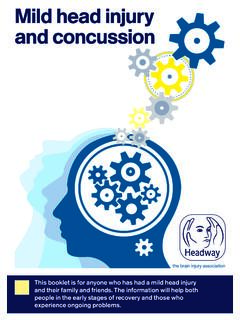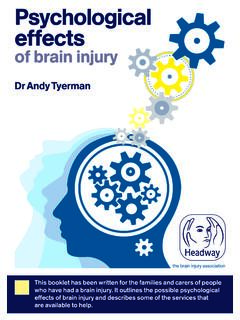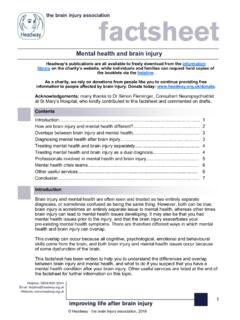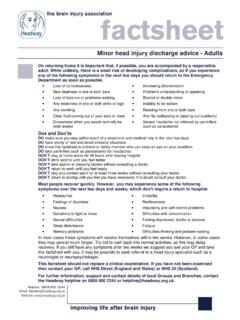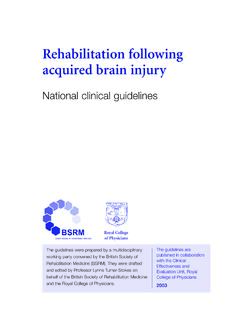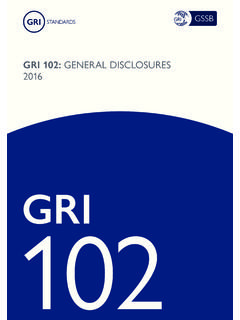Transcription of A BARRISTER’S GUIDE TO YOUR PERSONAL INJURY CLAIM …
1 A BARRISTER S GUIDE TO your PERSONAL INJURY CLAIM A Legal Lifelineedition one Julian BensonJulian BensonA BARRISTER S GUIDE TO your PERSONAL INJURY CLAIM A Legal Lifelineedition one A Barrister s GUIDE to your INJURY CLAIM First Edition, , August 2012 Published by Julian Benson PublishingCopyright 2012 Julian BensonISBN: 978-0-9574064-0-7 The GUIDE is intended to provide accurate information. It cannot and does not pretend to give advice in any specific situation. It is therefore not intended to be, and should not be taken as, a substitute for specific professional advice. The moral right of Julian Benson to be identified as the author of this work has been asserted by him in accordance with the Copyright, Designs and Patents Act 1988. All rights reserved. Except for the material freely available to download from the website , no part of this publication may be reproduced, stored in a retrieval system, or transmitted in any form or by any means (electronic, mechanical, photocopying, recording or otherwise) without the prior written permission of the copyright is the first edition of A Barrister s GUIDE to your PERSONAL INJURY CLAIM .
2 My website explains that the GUIDE is intended to provide clear, authoritative and independent advice about all aspects of PERSONAL INJURY claims in England and have practiced in the field of PERSONAL INJURY law for over twenty years, working for injured individuals and for clients (often insurers) defending claims. Particularly when defending claims, I have encountered many examples of individuals being badly advised. For that reason, as well as providing advice, the GUIDE will help you to ensure that you receive a professional service from your lawyers. That will, in turn, promote a fairer and quicker conclusion to your CLAIM . As and when changes take place which require amendments to this edition of the GUIDE , these will be available to download free from the website. You must visit the website every few months to check for have had a great deal of help and support in writing this GUIDE and setting up the website.
3 This includes an exceptional group of barrister colleagues and staff at Guildhall Chambers in Bristol, several of whom have assisted me to improve the GUIDE . The same is true of several professional clients, friends and family, especially my wife Pennie. I am extremely grateful to all of them. Jon and Nicola Payne of Noisy Little Monkey Ltd and Jamie Yearsley of Think Design have provided a superb professional and PERSONAL service in designing the website and advising me in many respects about the publication of the GUIDE . I bear the responsibility for any aspects of the GUIDE which could be improved, and would invite any suggestions which I could incorporate when updating the GUIDE , or in future editions. CONTENTSPart One: Introduction And Overview 1 Section 1: Aims of the GUIDE 2 Section 2: What you can expect from a CLAIM 7 Section 3: How does the law compensate me?
4 9 Part Two: your Relationship With Lawyers 13 Section 4: The different lawyers you will encounter and their roles 14 Section 5: Does it matter how you found your solicitor? 27 Section 6: Do I have to keep the same legal representatives? 29 Section 7: Finding new representatives 31 Section 8: Funding a PERSONAL INJURY CLAIM 33 Section 9: Who will pay my compensation if I am successful, and why? 36 Section 10: What aggravates insurers and how it can affect you 38 Section 11: Why did the insurer video me? 42 Part Three: What You Need To Know About The Law In Practice 45 Section 12: Introduction to evidence 46 Section 13: Pitfalls with expert evidence 52 Section 14: What is causation and why does it matter? 59 Part Four: Putting The CLAIM Together 63 Section 15: How you should approach the CLAIM 64 Section 16: Elements of the CLAIM 66 Section 17: The key litigation documents 72 Section 18: Further stages in the litigation 77 Section 19: Interim payments 83 Part Five: When And How Claims End 85 Section 20: When is it time to settle my CLAIM ?
5 86 Section 21: Offers to settle 87 Section 22: What if something goes wrong and/or I feel pressured to settle? 90 Section 23: A conference after the evidence is complete 92 Section 24: Joint settlement meetings 93 Section 25: Mediation/Alternative dispute resolution 95 Section 26: Trial 96 Section 27: Appeal 98 Part Six: The Award And Effect Of Compensation 99 Section 28: Lump sum or periodical sum 100 Section 29: Preserving your benefits after the CLAIM has finished 102 Section 30: Provisional compensation 103 a rare exception to finality in claims Part Seven: Final Thoughts 105 Section 31: Final thoughts 106 Part Eight: Additional Materials 107 Explanation of terms in the GUIDE 108 Stages in a typical INJURY CLAIM 112 Questions for your solicitor - or replacement solicitor 113 Client checklists on liability and valuation issues 115 PART OneINTRODUCTION AND OVERVIEWPart 1 - Section 12 SECTION 1.
6 AIMS OF THE GUIDETHE CONTEXT OF INJURY LITIGATION1. People get injured every day. Most injuries are simple accidents for which no one is at fault. However, some injuries are caused by fault, which gives rise to a possibility of compensation. The vast majority of such injuries arise from accidents on the road, in the workplace, or on land (or property) owned by another person (whether an individual, a company, etc.). 2. It is rare for individuals to suffer more than one INJURY giving rise to a CLAIM . Therefore, most injured individuals only become involved in a CLAIM once, and the process seems a mystery. 3. Although lawyers are experienced in many aspects of the process which are (understandably) unfamiliar to non-lawyers, a central message of this GUIDE is that the vast majority of the process is common Injured individuals often simply rely upon their lawyers to do the best for them because they have enough on their plate just to get through the day in their new circumstances.
7 5. It may very well be that most lawyers deserve that trust. This GUIDE is intended to help you to ensure that is the case, and that you are getting high quality legal advice and support, and in a timely fashion. The process often seems to be taking place around you, and to take an inexplicably long time to achieve progress. As I explain in section 2, there are often sensible reasons why progress is slow (for example, arranging medical examinations, or awaiting the outcome of treatment). However, you should be given a clear idea of the timescales involved, and reasons which prolong aspects of the CLAIM . You should also be kept updated rather than feeling embarrassed to telephone for progress, then frustrated if there is no news to report: section OF THE GUIDE6. Among the aims of the GUIDE are: (a) To demystify the legal process, so that you understand the process and the legal framework, what to expect and what role to play; (b) To enable you to contribute to building a clear and reasonable CLAIM , Part 1 - Section 13which will maximise the prospect that you will receive reasonable compensation by a settlement; (c) To assist you to assess the service that you are receiving from your own representatives, to identify problems early (so that they may be rectified), and ultimately, if the relationship breaks down, to replace your ABOUT THE PROCESS7.
8 The process of making a CLAIM , described in section 2, can be stressful, not least because one person (you) is trying to recover a financial loss caused by another person (or organisation). The process inevitably involves, on your side, blame ( you caused my INJURY ), and demand ( you have cost ), and on the opposing side, rejection ( I did not hurt you or you were partly at fault ) and refusal ( I will not pay you that ). Those issues inevitably give rise to disputes, many of which can be resolved, usually leaving a few more difficult issues to try to resolve by settlement. 8. The GUIDE is not intended to erect barriers between you and the party (usually an insurance company) most likely to pay your CLAIM if it succeeds. Everyone wants to keep their insurance premiums down, and insurers are bound to try to root-out unreasonable claims and keep genuine claims to a reasonable level: sections 9 - If, however, there is animosity or suspicion between the parties, it will become significantly more stressful, and the CLAIM will inevitably be more difficult to settle.
9 The GUIDE is intended to help you to understand, and avoid contributing to, such difficulties: sections 15 - MY CASE GO TO COURT 10. Many individuals ask will my case go to Court? They do not know what proportion of cases end with a trial or why, and they are also understandably nervous about going to Court . The simple fact is that a tiny proportion of claims end in a trial : section 26. However, it is almost always more sensible for your representatives to prepare your CLAIM as if it was going to end in a trial that way their work will be focussed on what the Claimant would have to prove to the Court. It is an excellent discipline, and it also helps to put together a CLAIM which is persuasive to the Defendant, and therefore has a very good chance of achieving a good settlement. Part 1 - Section 1411.
10 In a nutshell, provided you are well advised, there is a very good chance that your CLAIM will be settled at a reasonable IF your REPRESENTATIVES LET YOU DOWN12. This GUIDE is not intended to drive a wedge between you and your representatives. your interests and theirs ought to be the same: to achieve for you (almost always) by settlement, the highest sum in compensation which can reasonably be recovered. The fact that section 6 discusses changing representatives, reflects the fact that in some cases, for a variety of reasons, the relationship breaks down, and if that does happen you need to know what to do next. GUIDANCE AFTER your CLAIM HAS BEEN CONCLUDED13. This GUIDE may be of assistance to some readers who have concluded their claims, and feel that they were badly advised/represented, or pressured to settle their CLAIM against their wishes.


